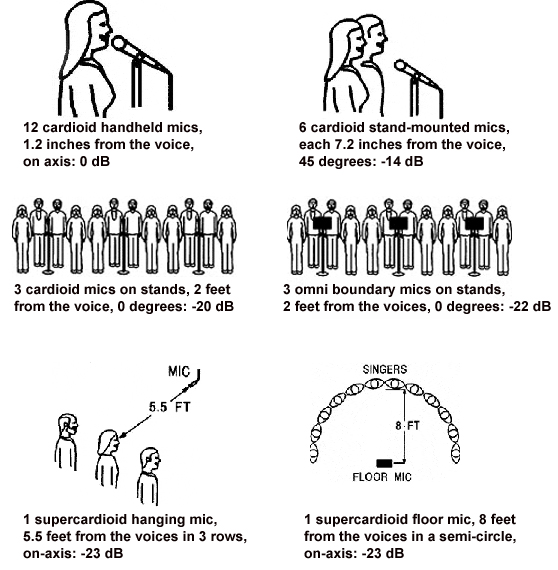
Some choir mics have a built-in hanger which comes with a tiny crossbar or pipe. You thread a fish line through this pipe and attach the line to screw hooks in the side walls (See the example photo of a miniature choir mic on the previous page to view how this should look.). The guy wire keeps the mics oriented toward the choir.
If hanging mics is not an option, you might try making some clear plastic mic stands of Lexan corner molding. The stands can be cut to the desired height and mounted to or near the choir rail.
What if the choir is under a balcony? Try mounting some supercardioid boundary mics to the bottom surface of the balcony, near its front edge.
Other Considerations
Monitor loudspeakers can easily feed back into the choir mics. To keep feedback under control, try not to use monitors near the choir.
Instead, turn up the house loudspeakers. If the choir insists on monitor loudspeakers, don’t feed a monitor signal of the choir back to them because it will cause feedback with the choir mics. Rather, just feed them some music for accompaniment.
If the choir members complain they can’t hear themselves, maybe the piano, organ, or music tracks are too loud in the choir monitor speakers. Have the choir sing a capella, with the air conditioning turned off. Can they hear themselves? Now turn on the air conditioning. Can they still hear?
Turn up the piano or organ in the choir monitors. Then turn up the tape tracks. At what point can the choir no longer hear their voices? Turn down the offending sound source.
In some venues the choir mics pick up too much of the organ’s sound. In this case, use supercardioid mics and aim them toward the middle row of the choir.
Because the mics partly reject sound from the side, they will pick up less of the organ in this configuration. If the organ is still too loud, aim the mics straight down over the choir and filter out frequencies below 100 Hz in the choir mics.
Smaller Choirs
Suppose you want to mike a small choir of about 12 people. Of course, you want the most gain-before-feedback possible, but you also want to keep the number of mics to a minimum, both to reduce cost and to simplify mixer operation.
Should you use one close-up mic per person? One mic on every two people, or one every four people? How about one mic on the entire group?
There’s a scientific way to answer these questions. It’s possible to calculate the gain before feedback (GBF) of a chosen mic setup, given these variables:
—Number of open mics
—Miking distance
—Mic polar pattern
—Angle of sound incidence to the mic
GBF drops 3 dB every time you double the number of open mics. GBF drops 6 dB every time you double the miking distance (not including proximity effect). Directional mics have more GBF than equivalent omni mics. With directional mics, on-axis sound sources produce more GBF than off-axis sources. The results of these calculations might surprise you.
Figure 2 shows several mic techniques and their calculated GBF, from best to worst. Note: The GBF of 12 close up mics was normalized to 0 dB.

What do the results show? If a facility can afford 12 mics, and can handle that many on the mixing console, go for it – 12 close-up mics give the best GBF, by far.
If six mics make more sense, you save cost and complexity, but give up about 14 dB GBF. That’s not necessarily a problem, depending on the venue, mics, and loudspeaker placement.
When using six mics to pick up 12 people, the singers must be relatively far from the mics, and about 45 degrees off axis in relation to them. So six distant mics have much less GBF than 12 close-up mics.
If the customer wants the simplicity of a single mic on the choir, try either one hanging supercardioid mic or one floor-mounted supercardioid mic. Either should provide about 23 dB less GBF than 12 handheld mics, but this approach could work suitably anyway.
All of this is theoretical, and assumes that the mics have textbook polar patterns. Your real-world results may vary! But these findings might suggest some tendencies helpful to know.
